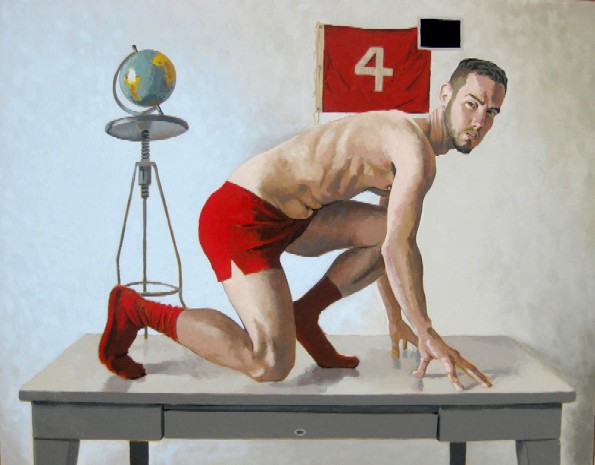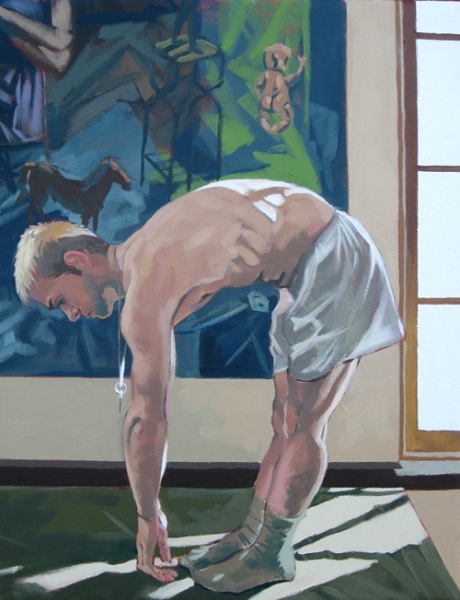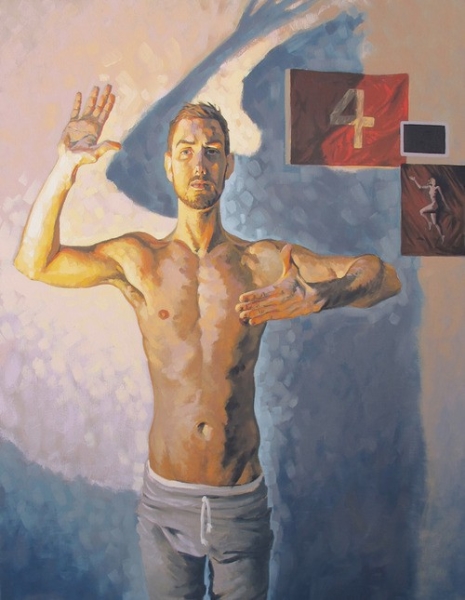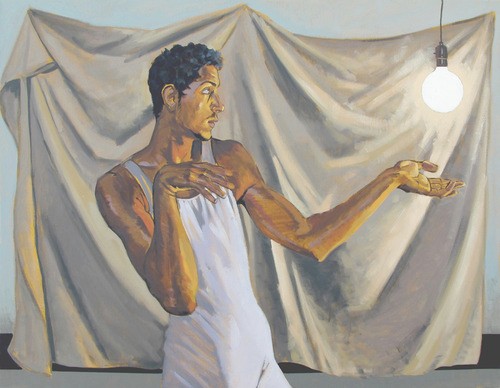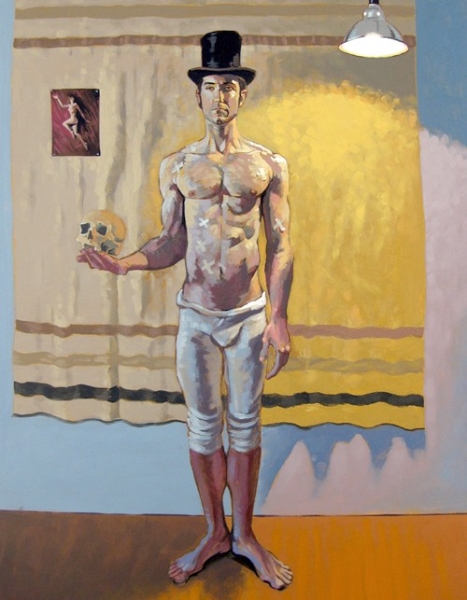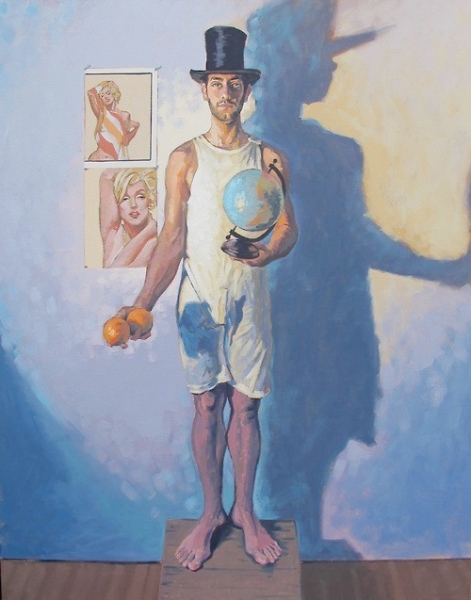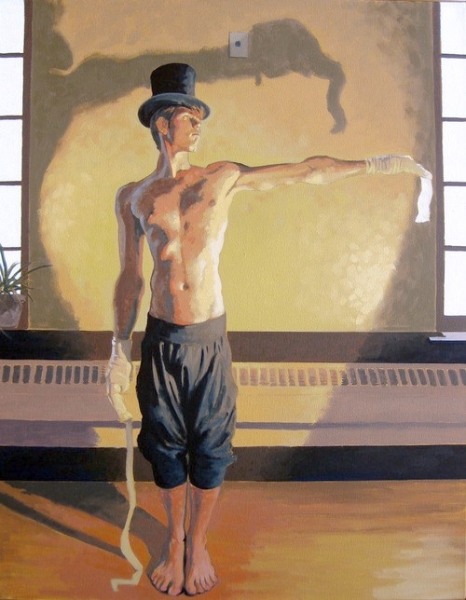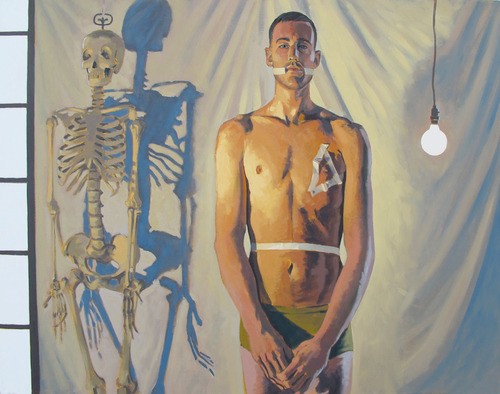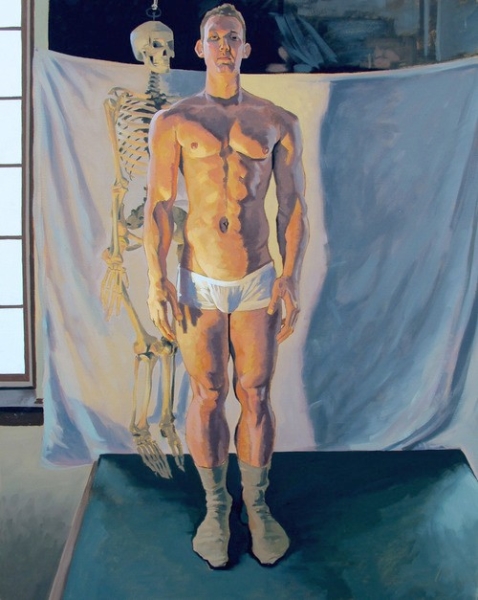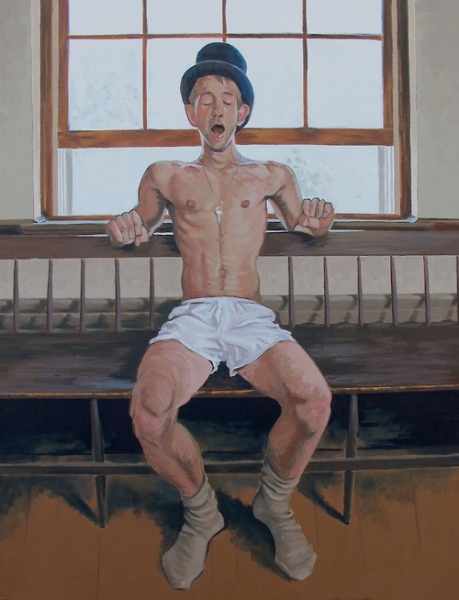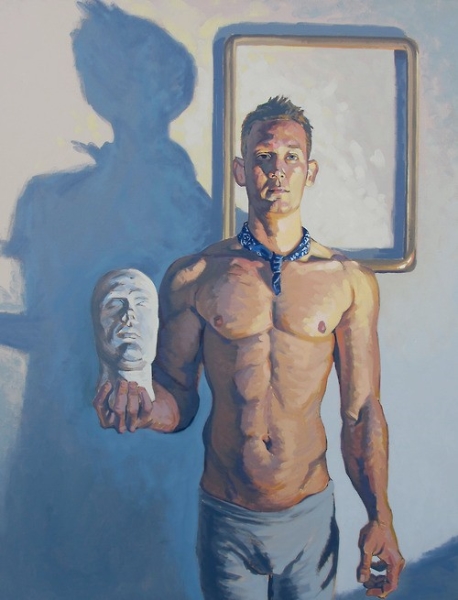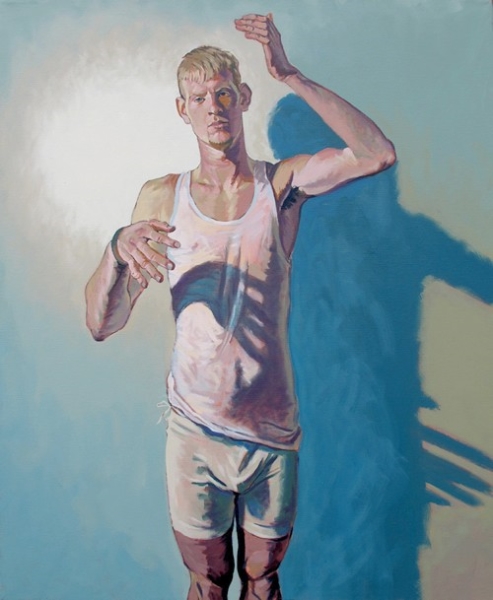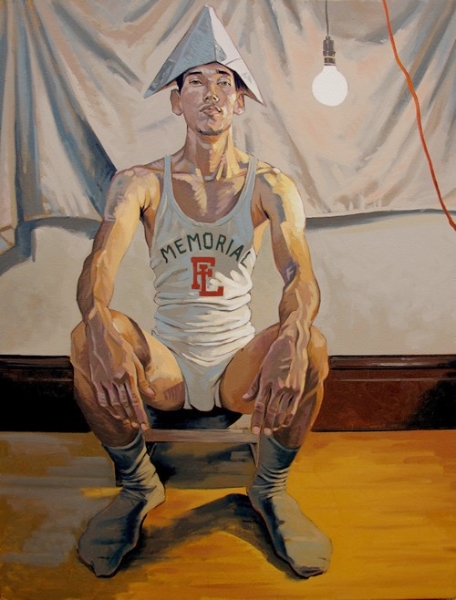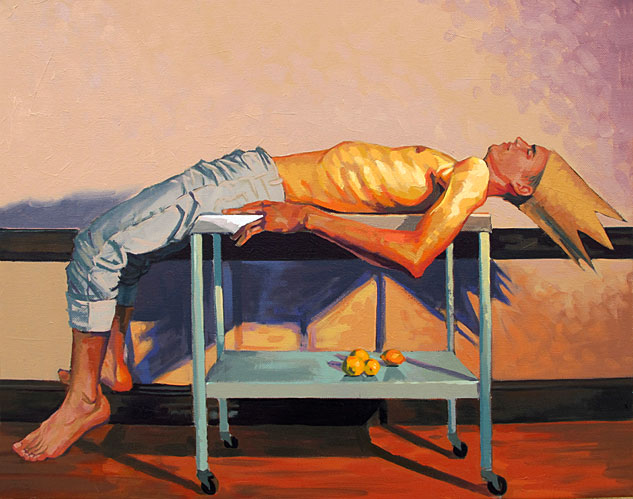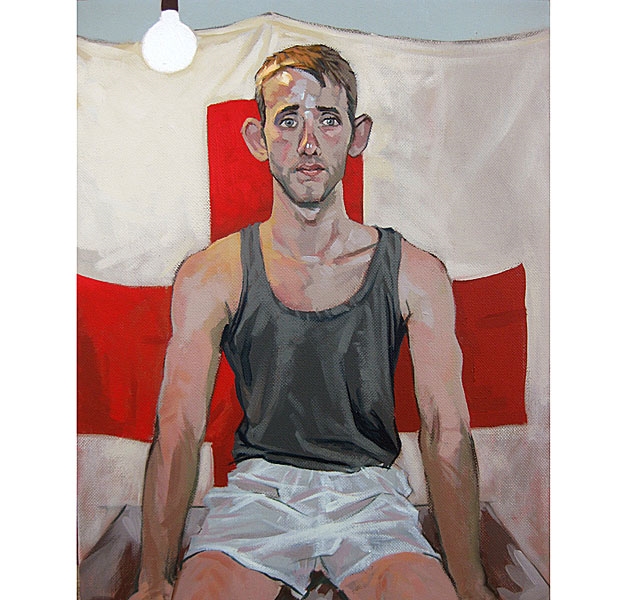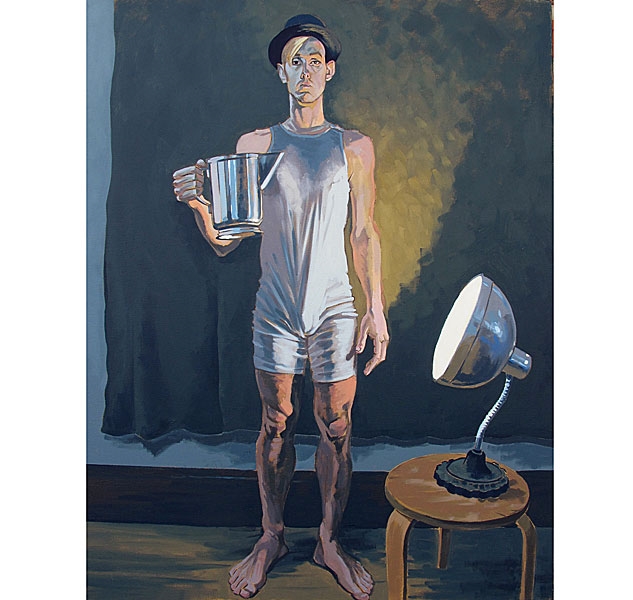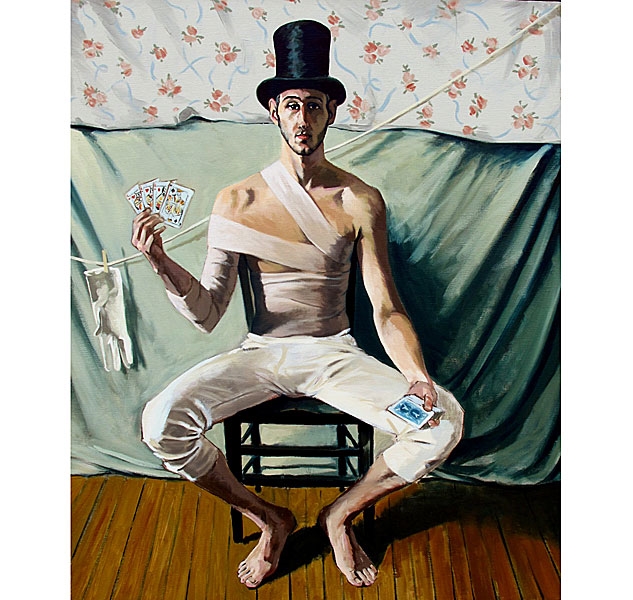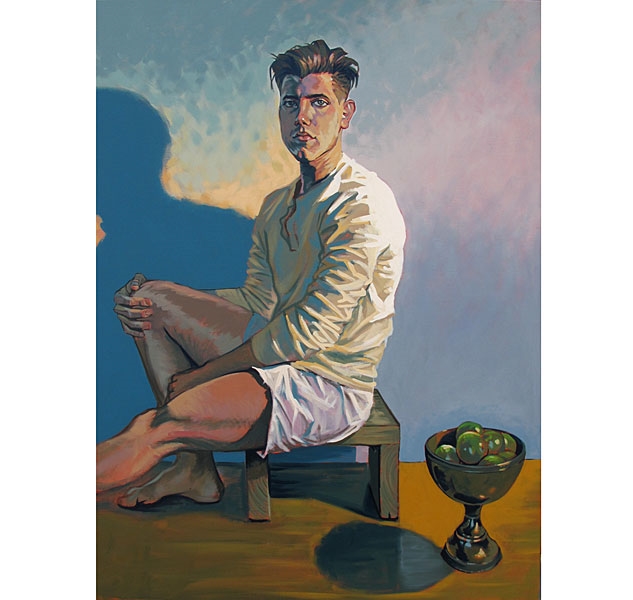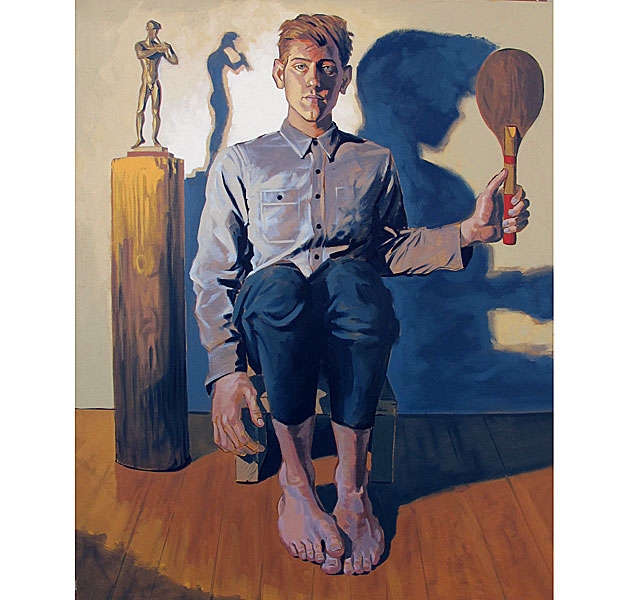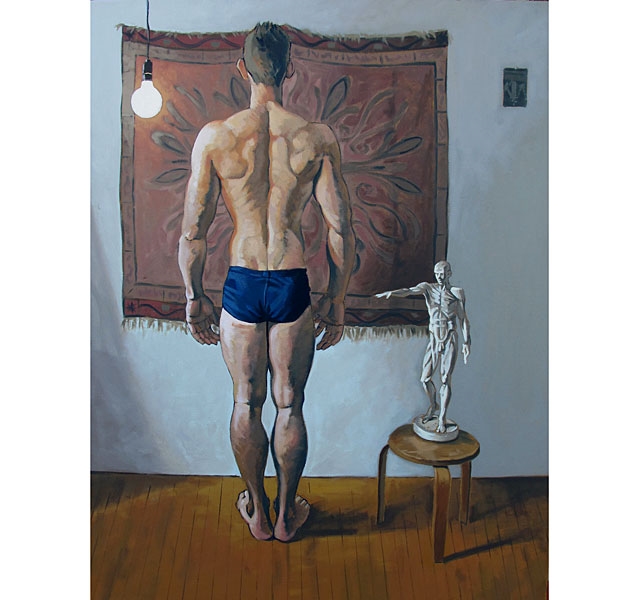
By Millicent Accardi, Contributor (*)
Portuguese-American artist Christopher Sousa is a self-taught painter originally from Fall River, Massachusetts, whose influences range from Lucien Freud, to Jenny Saville. He has been calling Provincetown, MA, his home for the past ten years and after four sold out solo art shows, Sousa has established a strong reputation in the local arts community as a bold and brilliant painter.
Adam Peck, owner of A Gallery, suggests Sousa will have a long career and maintains “One day [Sousa] will be considered one of the great Provincetown artists. Decades from now people will walk into a room and say, ‘Is that a Christopher Sousa?’”
In this interview for the Portuguese American Journal Christopher Sousa kindly agreed to answer a few questions about his art, and his life as a Portuguese-American.
What is your family background?
My mother is Italian and my father Portuguese, but my father wasn’t close with many relatives, so I don’t know very much about that side of my family. My father was an only child and his father died when he was 5. I know very little about him, but I believe he was born in Portugal. My Portuguese grandmother’s maiden name was Cabral, and I’m told she was born in Bermuda.
One thing I’ve found interesting about my heritage is how, depending where I’m living, being Portuguese is viewed differently. Growing up in Fall River there was a huge Portuguese community, I probably knew more Portuguese people than any other nationality. My family later relocated to Taunton, MA, and similarly, there were loads of Portuguese residents. We were the working class for the most part, the “regular people.” In the 90s, I moved to Los Angeles, briefly and suddenly. For the first time in my life people didn’t know how to pronounce my last name and they seemed to think being Portuguese was somehow exotic and unusual. They all asked if I was related to John Philip Sousa (I’m not, as far as I know.)
When I eventually settled in Provincetown, a town in Massachusetts with a rich Portuguese heritage, I felt very welcome and more than once I would meet people and they would say “Sousa? Oh, you must be a local.” I remember, shortly after I moved here, some friends and I were looking for a place to eat on a busy summer evening. I went up to the maître d’, at a popular restaurant, and explained that we were looking to have dinner but didn’t have reservations. He told me “Well, there will be a long wait. What’s your name? I’ll put it on the list.” When I told him my name was Sousa, he smiled and responded “Sousa? Oh, well, I think we can find a table for a nice Portuguese boy,” and seated us immediately.
Did your parents pass along any Portuguese superstitions?
Not my parents, no. But when I was in high school I had a summer job mowing lawns in cemeteries around town. Several of my co-workers were also Portuguese and they became my buddies that summer. One afternoon during work we had a sunshower. One of my Portuguese friends told me that his grandmother used to say that if it rains when the sun is shining, that means that a witch is getting married. He said that was an old Portuguese saying. I always thought that it was interesting and funny and I still repeat it whenever there’s a sunshower.
What’s your favorite Portuguese food?
When I was growing up, my grandmother would frequently make us chouriço and peppers sandwiches. That was always a favorite of mine. I became a vegetarian 27 years ago, so, unfortunately, I haven’t had it since! I do miss it, though. Here in Provincetown there is a Portuguese festival that happens every year where they have a big outdoor festival with fado music, folk dancers in traditional Portuguese dress and a parade down the main street. The smell of the chouriço and linguiça cooking at the festival always makes my mouth water.
How did you start making art? Why do you make art?
I’ve been drawing and painting and making things since I was a little kid. I really don’t know why I’m compelled to do it, but I just know it’s what I want to do. It’s all I’ve ever wanted to do. It’s the only goal or ambition I’ve ever had. Making loads of money never mattered to me, I never cared about social status or owning property, I just want to make things I can be proud of.
Shifting gears, now, to your artwork. Many of your paintings incorporate set ups, props and hats. Do these have a specific story? Or, are they there to add interest to the subject?
A little bit of both. Initially I began using props and unusual outfits because I was working on a series of paintings inspired by the work of a photographer, E.J. Bellocq. I was making a conscious effort to emulate his work. Eventually though, the “prop trunk” just sort of began evolving and now includes a lot of items that are specific to certain personal memories or experiences that I wanted to somehow incorporate into what I’m doing. I’m always very conscious or symmetry and composition and I try to include objects that I think are visually arresting as well as personally relevant.
What’s in your Prop Trunk?
Well, it’s not really an actual trunk, more of a series of small piles of stuff. There are antique top hats and bowlers, old wool bathing suits from the turn of the last century and wrestling singlets, military uniforms and union suits. Also objects such as globes, a plaster life mask of the head of James Dean, broomsticks, a dodgeball, an antique ping-pong paddle, several large whale bones I found on the beach. All kinds of things, really. Anything I come across that symbolizes something to me or that I feel will add something visually to a composition.
I see you sometimes use your own paintings in the background, as a recurring theme. That interests me a lot. Is there a particular communication in doing that?
Actually, I’ve never used my own paintings, but I’ve used paintings by one of my two studio mates, both are amazing artists–Larry Collins and David Foley–but Larry is the one whose paintings pop up here and there in the background of my paintings. He has some very large works that take up a huge amount of wall space. I was posing a model on a table in front of one of his huge paintings one day and was going to cover it with a sheet (as I usually did,) but decided to leave it and asked him if I could include it in my painting. He liked the idea and I’ve done it several times now. I find it fun and challenging painting someone else’s painting. You have to sort of reduce it and put it in your own terms. I also sometimes hang pictures on the wall behind the model – pages from magazines or books – things that resonate with me for one reason or another. People always ask me what my paintings mean, what they’re about. I think that the objects in the background, particularly pictures hanging on the wall, might provide more clues to the meaning of my work than any other element.
Do you work on one painting at a time or do you rotate? My husband is an artist and he is happiest when he has three paintings going on at once. One, he is struggling with, one he loves and one that is just so-so.
I actually tend to work on multiple paintings at once, sometimes as many as six or eight. When I am struggling with one piece it sometimes helps to put it aside and focus on something new or different for a while and then come back to the first piece later. It helps clear my head and makes problem solving much easier. And sometimes I just end up going back to the first piece and realizing that it’s just not going to happen and painting over it. I think it’s important to know when to call it a day.
Do you listen to music while you paint?
As odd as it may seem, music is a really important part of painting for me. Music has always been my preferred mode of escapism since I was a teenager. It puts my head in a different place, relaxes me. I have a huge, ever growing pile of CDs in my studio which I’m sure drives my studio mates crazy, but I really don’t function well without it. I choose what I’m going to listen to depending on my mood. I might be in a dark funk and want to stay there for a while. So, I’ll play Joy Division or other music that’s conducive to this. Or, I may be feeling anxious or happy and want to really harness that particular feeling. Lately I’ve been listening to a lot of vintage Springsteen and a guy called Dirty Beaches. I suppose it sounds silly, but I think music helps me to distill what’s in my head.
Which is more important to you, the subject of your painting, or the way it is executed?
I think they are equally important. I work really hard trying to hone my technique. I’m constantly striving to improve it and become a better painter. I’m rarely completely happy with my work; I always think there’s something I could have done better. But, at the same time, I’m always trying to evolve in terms of subject matter also. My focus has always been the figure, but I’m not really satisfied just painting a picture of a person. I want it to say something more, make the viewer wonder what’s going on, why I chose to portray the subject in that particular light, or that particular outfit.
Which of your pieces is your favorite?
I generally don’t feel much of an attachment to my own work. Usually by the time I’m done with a painting the fascination has waned and I’m happy to never see it again. But there’s one I did early last winter called “Pining for the Moon” which I’m really fond of. I’m just really pleased with how it came out. I like the composition and the way the objects are laid out. The model was probably my favorite model that I’ve ever worked with. And there’s a lot of red in that painting, which just really works for some reason. I’d have to say that’s my favorite of my own paintings.
How do you know when a work is finished?
You know how in Tennessee Williams’ Cat On a Hot Tin Roof the character Brick says he knows he’s had enough to drink when the “click” happens inside his head? It’s kind of like that for me. I just keep working, sometimes to the point of intense frustration until something just “clicks” and suddenly it all feels right. That’s how I know.
How would you respond to the description of your paintings as being figurative still lifes?
Several people have told me my work reminds them of still life painting. I’m OK with that. I like it. I tend to use a model as I would any other object in the composition. I pose them very deliberately and specifically. I place them, I position their limbs. I don’t want my paintings to be about the personality of the subject. Most of the time, the subject is representative of something else. I think I use a model the same way I would an apple or a chair. It’s really just one part of a larger whole.
Click on any picture to enlarge to full screen or to return to regular size.
With sold out shows, and much acclaim, Christopher Sousa is primed for breaking out into the major leagues of the art world. In fact he has three upcoming shows this summer in Provincetown.
“The Dog That Guards the Gates” runs from July 10 – 16th, with an Opening Reception Friday, July 12 @7- 10 PM and a second solo show August 21st through the 27th, both at A Gallery. Call for more information: (508) 274-8298. A Gallery is located at 192 Commercial Street in Provincetown, MA 02657 or online at agalleryart.com
“Triplicate,” featuring work by Sousa, Larry Collins and David Foley at Larry Collins Fine Art 145 Commercial Street #2, Provincetown, MA 02657 Or call (508) 487-6600 Larry@larrycollinsfineart.com for more information. Also check Christopher Sousa @ OUT Travel
_____________
 (*) Millicent Borges Accardi is a contributor to the Portuguese American Journal. She is a Portuguese-American poet, the author of three books: Injuring Eternity (World Nouveau), Woman on a Shaky Bridge (Finishing Line Press chapbook), and Only More So (forthcoming from Salmon Press, Ireland). She has received literary fellowships from Canto Mundo, the National Endowment for the Arts, and California Arts Council. Last fall, she was a visiting poet at The Muse Writers Center in Norfolk, VA. Millicent lives in Topanga, CA. Follow her on Twitter @TopangaHippie
(*) Millicent Borges Accardi is a contributor to the Portuguese American Journal. She is a Portuguese-American poet, the author of three books: Injuring Eternity (World Nouveau), Woman on a Shaky Bridge (Finishing Line Press chapbook), and Only More So (forthcoming from Salmon Press, Ireland). She has received literary fellowships from Canto Mundo, the National Endowment for the Arts, and California Arts Council. Last fall, she was a visiting poet at The Muse Writers Center in Norfolk, VA. Millicent lives in Topanga, CA. Follow her on Twitter @TopangaHippie
Related Posts:
- Artist Spotlight: Christopher Sousa – Review
- Provincetown Celebrates Portuguese Festival
- Portuguese Festival Reading – Provincetown
Recent Posts by Millicent Accardi
- Opinion: Porto book fair canceled after nearly a century – Portugal
- Brian Sousa: Sempre p’ra Frente (Always Forward) – Interview
- Frank X. Gaspar a much beloved writer – Interview
- Anthony De Sa’s raw fiction tells of bitter love and triumph – Interview
- Memoir: Philip Graham abroad in Lisbon – Interview
- Nuno Júdice: One of Portugal’s greatest literary treasures – Interview
- Rogério Puga: His work on Macau and his wide literary interests – Interview
- Linette Escobar’s gift of self goes beyond her community – Interview

